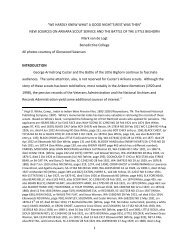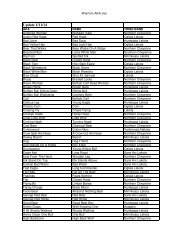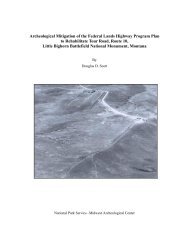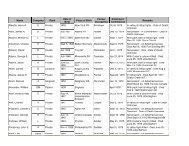Investigating the Oxbows and Testing Metal Detector Efficiency
Investigating the Oxbows and Testing Metal Detector Efficiency
Investigating the Oxbows and Testing Metal Detector Efficiency
Create successful ePaper yourself
Turn your PDF publications into a flip-book with our unique Google optimized e-Paper software.
Executive Summary<br />
The oxbow inventory found no archeological materials predating <strong>the</strong> late nineteenth century in<br />
any of <strong>the</strong> three oxbows within <strong>the</strong> Custer battlefield area. All late nineteenth <strong>and</strong> early twentieth<br />
century artifacts were found on relatively stable l<strong>and</strong>forms near <strong>the</strong> mouths of ravines or just<br />
below <strong>the</strong> steep slopes of <strong>the</strong> main battlefield. Dense vegetation prevented intensive metal<br />
detecting of <strong>the</strong> actual oxbows, but where opportunistic sampling did occur only artifacts dating<br />
to <strong>the</strong> mid to late twentieth century were found, <strong>and</strong> those usually buried between 25 <strong>and</strong> 30cm.<br />
The river bank was also visually inspected where it was accessible <strong>and</strong> visible. No culturally<br />
deposited soil strata were observed. The soil depositional sequence observed in <strong>the</strong> river bank<br />
appeared to be water laid deposits. This suggests that modern sedimentation associated with<br />
periodic modern flooding of <strong>the</strong> floodplain has scoured out <strong>the</strong> 1876 period surface or buried <strong>the</strong><br />
1876 era level well beyond <strong>the</strong> potential level of metal detecting capability of ei<strong>the</strong>r VLF or PI<br />
metal detectors.<br />
A preliminary assessment of various historic maps was conducted to determine which may be <strong>the</strong><br />
most reliable in depicting <strong>the</strong> 1876 river channel. The method involved georeferencing <strong>the</strong><br />
historic maps to <strong>the</strong> modern topographic <strong>and</strong> aerial photography <strong>and</strong> establishing a root mean<br />
square error calculation. This objective analysis was coupled with a subjective analysis of <strong>the</strong><br />
river channel <strong>and</strong> terrain features depicted on <strong>the</strong> subject map. A preliminary assessment of <strong>the</strong><br />
historic maps suggests that Maguire Map 8 <strong>and</strong> <strong>the</strong> Norris map have potential to aid in sorting<br />
out <strong>the</strong> 1876 river channel if used judiciously. The 1883 Blake map may show <strong>the</strong> river<br />
me<strong>and</strong>ers most accurately in <strong>the</strong> area of <strong>the</strong> Custer field than o<strong>the</strong>r maps preceding or post-dating<br />
it. The 1891 topographic map seems to be generally correct except for <strong>the</strong> location of <strong>the</strong><br />
sou<strong>the</strong>rnmost oxbow at Custer field, which is <strong>the</strong> one currently threaten by erosion.<br />
The absence of metal in <strong>the</strong> detectable range <strong>and</strong> <strong>the</strong> preliminary assessment of <strong>the</strong> historic maps<br />
suggest <strong>the</strong> oxbows are not likely to contain archeological evidence of <strong>the</strong> battle. However, no<br />
formal geomorphological investigation of <strong>the</strong> river channel, ab<strong>and</strong>oned river channels, or <strong>the</strong><br />
oxbows has been undertaken to date. It is recommended, before determining if additional<br />
mitigation measures are required a professional geomorphological study of <strong>the</strong> river channel is<br />
done. Such a study has <strong>the</strong> potential to posit chronological changes in <strong>the</strong> riverbed <strong>and</strong> more<br />
accurately define <strong>the</strong> 1876 channel, as well as determine if historic surfaces may still exist as<br />
buried soil horizons.<br />
Since field time permitted a more formal test of <strong>the</strong> capability of <strong>the</strong> VLF <strong>and</strong> PI metal detectors<br />
was undertaken. Two previously inventoried areas were redetected. One test area encompassed a<br />
known warrior fighting position <strong>and</strong> <strong>the</strong> o<strong>the</strong>r was a known soldier position. Each area yielded<br />
additional artifacts. Fifty-seven percent of <strong>the</strong> artifacts were not battle-related, 43% were battlerelated,<br />
90% were found by <strong>the</strong> VLF machines, <strong>and</strong> 10% were found by <strong>the</strong> PI metal detector<br />
alone. The test indicates <strong>the</strong> 1984 sample strategy was sound in that it did recover a<br />
representative sample of <strong>the</strong> range of artifact types present. The PI metal detector did find about<br />
10% more than <strong>the</strong> VLF machines. Most of those items were ei<strong>the</strong>r deeper than <strong>the</strong> capability of<br />
<strong>the</strong> VLF machines or were items that were very small <strong>and</strong> were missed by <strong>the</strong> VLF machines.<br />
The test grids indicate <strong>the</strong> PI metal detector has <strong>the</strong> potential to increase artifact recovery in areas<br />
where materials may include very small or deeply buried artifacts.<br />
i








